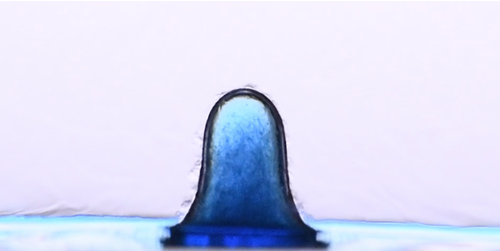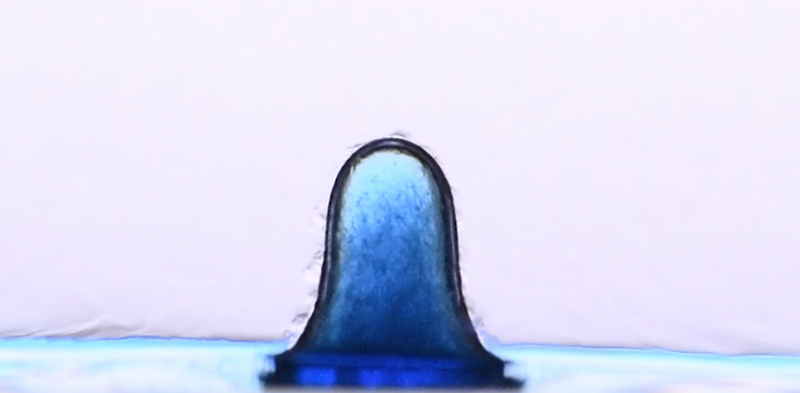Award-Winning Fluid Videos
Water drops that vibrate, flames that oscillate, and viscous fluids that form rivulets all won the top prize in this year’s Gallery of Fluid Motion video competition at the APS Division of Fluid Dynamics (DFD) conference in Atlanta. The Division presents the Milton van Dyke Award annually to the creators of three videos (and three posters), judging the works on their artistic value, scientific content, and originality. Accompanying papers will appear in Physical Review Fluids next year.
The Gallery of Fluid Motion contest has been an annual event at the DFD meetings since 1983 and was largely inspired by An Album of Fluid Motion, a 1982 book of black-and-white photos produced by the late Stanford engineering professor Milton Van Dyke. Like the book, the photo and video contests emphasize both the art and the science of fluid mechanics and the ability of beautiful images to interest the general public, says Kenneth Kiger of the University of Maryland, College Park. Kiger has run the competition since 2011.
“I have been captivated by the Gallery since I first saw it as a beginning PhD student at the APS meeting in Scottsdale in 1991,” Kiger says. “I had always been attracted to fluid dynamics as a discipline due to the beauty that I saw in the diversity of its motion,” along with the variety of applications, he adds. Kiger feels that the Gallery embodies a similar spirit.
In one of this year’s three winning videos, a drop of blue-dyed water at the bottom of an anise-oil and alcohol mixture begins to grow and shake, eventually pinching off a fragment that floats up. The process repeats several times. Created by now four-time Gallery-of-Fluid-Motion winner Oscar Enríquez of Carlos III University of Madrid and his colleagues, the visuals are accompanied by a soundtrack featuring a musical improvisation by a trio consisting of Enríquez on percussion, a violinist, and a clarinetist. Each instrument in the trio represents one of the three fluids.
Enríquez and his colleagues stumbled across the behavior while preparing to study a different phenomenon. They happened to place a water drop in the oil-alcohol mix and noticed the drop start to shake. “We’d never seen anything like that, and we were quite puzzled as to what was going on,” Enríquez says. After further experiments it became clear that the alcohol somehow allows anise oil to enter the water drop and form an emulsion—a collection of tiny oil droplets—inside the drop. At the same time, the alcohol enters and mixes with the water, causing the drop to grow and become less dense. Eventually, this density reduction raises the buoyancy enough that a portion of the drop pinches off and floats away.
But many questions about the phenomenon remain, for example, why exactly does the drop shake? The team is investigating these issues, but in the meantime, Enríquez enjoys using his visually appealing video to promote discussions about physics with students, family, and friends. And his musical ensemble hopes to accompany the video live in a concert someday.
Another Van-Dyke-winning video, by Daniel Martínez-Ruiz of the Technical University of Madrid and his colleagues, shows the effects of the fuel-to-air ratio on the shape of a propane flame confined to a cell measuring 100 by 50 by 1 cm. The flame front is corrugated but relatively stable for lower values of the fuel-to-air ratio. Above a critical value, however, the flame front develops wild forward-backward oscillations, thanks to acoustic waves excited inside the cell. The team says that the work is relevant for engines and gas turbine combustion chambers, which often experience so-called thermoacoustic oscillations that can affect performance.
The third winning video, by Gaétan Lerisson of the Swiss Federal Institute of Technology in Lausanne and his colleagues, shows that a viscous fluid flowing down an inclined plane can produce surprising patterns. With the correct flow rate and inclination angle, the fluid spontaneously forms narrow rivulets that can also carry droplets on top of them. The work could be useful for understanding geological formations, such as ice falls (frozen water falls), and industrial coating processes, according to the researchers.
–David Ehrenstein
David Ehrenstein is the Focus Editor for Physics.
See the winning videos, along with 100 other contest entries, at the Gallery of Fluid Motion.
An Album of Fluid Motion by Milton Van Dyke is out of print but is available as a pdf for free.





